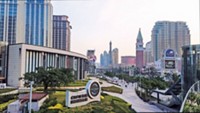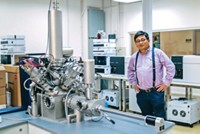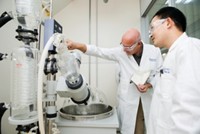Advertisement
Grab your lab coat. Let's get started
Welcome!
Welcome!
Create an account below to get 6 C&EN articles per month, receive newsletters and more - all free.
It seems this is your first time logging in online. Please enter the following information to continue.
As an ACS member you automatically get access to this site. All we need is few more details to create your reading experience.
Not you? Sign in with a different account.
Not you? Sign in with a different account.
ERROR 1
ERROR 1
ERROR 2
ERROR 2
ERROR 2
ERROR 2
ERROR 2
Password and Confirm password must match.
If you have an ACS member number, please enter it here so we can link this account to your membership. (optional)
ERROR 2
ACS values your privacy. By submitting your information, you are gaining access to C&EN and subscribing to our weekly newsletter. We use the information you provide to make your reading experience better, and we will never sell your data to third party members.
Business
China Bets Big On Drug Research
Money and accomplished scientists boost efforts to build world-class pharmaceutical institutes
by Jean-François Tremblay
March 4, 2013
| A version of this story appeared in
Volume 91, Issue 9

Basic research has long been the missing foundation of China’s aspiration to develop a world-class drug industry. The country has become a global powerhouse in the manufacture of bulk pharmaceutical chemicals. It is a preferred destination for major drug companies that outsource research work to reduce costs. To date, however, none of the world’s major drugs has been either invented or developed in China.
The country wants to change that in a big way. The government is spending $7 billion over the next five years on academic research projects that might yield new drugs. The investment is just one part of an ambitious effort to foster an innovation-driven pharmaceutical industry.
Given the difficulty of successfully launching a commercial drug, no one knows whether the effort will pay off. But throughout the country, university departments and government-financed pharmaceutical research institutes are busily equipping labs with expensive instruments and recruiting notable scientists from abroad.
“China is about to become the world’s second-largest health care market because of rising affluence and longer life expectancies,” says Xiaodong Wang, director of the National Institute of Biological Sciences (NIBS), in Beijing. “Drugs need to be developed here.”
A member of the U.S. National Academy of Sciences, a former Howard Hughes Medical Institute investigator, and the one-time chair of biomedical sciences at the University of Texas Southwestern Medical Center, Wang knows how science is done in the West. “I came back to China to establish this institute as a truly elite research establishment by world standards,” he says.
With labs and offices covering 300,000 sq ft, NIBS was set up in 2005 and was running at full speed by 2010, Wang says. About 500 scientists, recruited from around the world, now work there.
One of the institute’s main missions, he says, is to turn fundamental science into ideas for drug research and development. Unlike in the U.S., where lines between basic and applied research are clearly drawn, in China many researchers have the market in mind. NIBS scientists focus on areas such as oncology, hepatitis B, obesity, and substance addiction. A multifunctional facility, NIBS boasts biology labs and 70 chemistry hoods.
New institutes such as NIBS are helping China expand its output of world-class drug discovery research papers. At the American Chemical Society’s Journal of Medicinal Chemistry, about 8% of the papers published in 2012—71 of 890—were from China-based researchers. This compares with only 3%—24 of 836—in 2008.
“The quality of papers from China submitted to the Journal of Medicinal Chemistry has steadily improved over the last 10 years,” says Shaomeng Wang, one of the journal’s co-editors-in-chief and the director of the Cancer Drug Discovery Program at the University of Michigan, Ann Arbor.
In addition, Chinese researchers and companies are filing a growing number of pharmaceutical patents, in contrast with Europe and the U.S., where decline is the trend. The U.S. led China in filing pharmaceutical-related patents in 2005, using a broad definition that includes new uses for an existing drug. But by 2012, Chinese researchers had filed three times as many drug patents as their U.S. counterparts had, according to an analysis conducted by Chemical Abstracts Service, a division of ACS.
For years, Chinese-born scientists who were trained abroad have been going back to China to take advantage of the opportunities there. But accomplished scientists who aren’t Chinese are starting to set up labs there too.

“China is where it’s all happening now. This is the country where the pharmaceutical sector is in full growth,” says Jay S. Siegel, director of the Organic Chemistry Institute at the University of Zurich. Later this year, Siegel is moving to North China to become dean of the School of Pharmaceutical Science & Technology at Tianjin University.
In Southwest China, renowned Scripps Research Institute of California synthetic chemist K. C. Nicolaou is a visiting scholar of the newly formed Innovative Drug Research Center (IDRC) of Chongqing University. He visits his labs there every few months, interacting with postdocs, teaching, and supervising graduate students.
A visit to IDRC provides a vivid example of what China is doing to boost its drug R&D capabilities. The center opened its doors in October 2011 and is very much a work in progress. Yet it is poised to become one of China’s premier drug discovery centers.
The central government in Beijing is spending lavishly on pharmaceutical research. Beijing’s $7 billion budget for drug-related academic research is part of the country’s current five-year plan, which runs to the end of 2015, and the institute will eventually get a piece of it. The municipal government of Chongqing is also funding pharmaceutical research as part of an effort to modernize the local drug industry. At the moment, IDRC gets most of its financial support from Chongqing University, whose new president, Jianhua Lin, wants to boost scientific research.
IDRC’s five-floor building can house up to 20 principal investigators in spacious labs. Once the institute fills all this space, it can expand into an adjacent building now under construction, says Yong Qin, the director of IDRC. Qin, who both trained as a postdoc and worked as a medicinal chemist in the U.S., was recently vice dean of the School of Pharmaceutical Sciences of Sichuan University.

The institute is in the midst of a global effort to attract talented scientists. Qualified junior faculty recruits can expect $320,000 as a start-up research package, free accommodations on campus, a tenure-track position, and an annual salary of $40,000. That salary may seem low, but “considering that costs of living in Chongqing are far lower than in other major cities, we think this package is very competitive, even by international standards,” Qin says.
Non-Chinese scholars can apply for positions at the institute, Qin says, although he does not expect many takers. “I would worry about their ability to deal with the challenges of daily life in China,” he reflects. Within IDRC’s walls, however, almost everyone is fluent in English. Two of the 30 postdocs IDRC recruited are Indian.
To outfit the new labs, the institute is acquiring equipment and instruments according to the needs of its scientists, Qin says. “The equipment is basically the equivalent of what I had access to when I was in the U.S.,” confirms Wei-Dong Li, deputy director of IDRC and a professor there. From 1995 to 1998, Li was a postdoc training with professor E. J. Corey at Harvard University.
At its name suggests, IDRC’s main mission is to pursue research projects that can lead to the launch of commercial drugs. The institute will work closely with pharmaceutical companies in the Chongqing area to achieve this goal.
“Chongqing University will assess our performance not only in terms of our publication record and number of students trained, but also in terms of how valuable our economic contribution to industry is,” says Yun He, an IDRC professor of medicinal chemistry who is also an adviser to Chemical Abstracts Service. IDRC will collaborate with industry on drug discovery as well as applied research projects like the development of new manufacturing processes, he adds. Before joining IDRC, He managed drug discovery projects at Abbott Laboratories, Novartis, Roche, and drug discovery services provider BioDuro.
Contributing to society is a common theme among academics who conduct drug research in China. In the country’s southeast, Liang Liu, the rector of Macau University of Science & Technology (MUST), aims to establish Macau as an internationally respected center of research. “We have to find a way to diversify Macau’s tourist-dependent economy,” Liu says. Right now, the region is known as southern China’s gambling mecca. “We can improve Macau’s society through research and education.”
Created in 2000, MUST is oddly located amid the casinos that dominate the area. A fraction of the size of neighboring Hong Kong, Macau is geographically challenged. Scientific research, Liu says, is a particularly suitable way of diversifying the Macau economy because it requires little land.
In addition to being university rector, Liu actively participates in scientific research. He is head of the State Key Laboratory of Quality Research in Chinese Medicine, a beautifully equipped 60,000-sq-ft lab financially supported by Macau but integrated into China’s pharmaceutical research network.
One of 30 State Key Laboratories in China, the lab has a mission of improving the quality of traditional Chinese herbal products by improving product stability, raising consistency from batch to batch, and setting up quality assessment criteria. Its 32 principal investigators also use the facilities to research Chinese medicines, with a particular focus on understanding how they can help with inflammation and cancer.

Trained as a medical doctor, Liu has studied traditional Chinese medicine for decades, both in China and in Germany at Hannover Medical School and the Max Planck institutes. Liu doubts that he would have accomplished as much as he has by staying abroad. In January, at a ceremony attended by China’s top political leaders, including President Hu Jintao, he received a prize for his work on quality-control innovations and bioactivity assessment for herbal arthritis treatments. This research has yielded commercial products sold in China.
For Yi Zhun Zhu, another Chinese scholar who studied in Germany, the decision to return to China has also worked out well. In Shanghai, where he was born, he is dean of Fudan University’s School of Pharmacy, where he leads 108 academics and manages a group of about 30 researchers.
Zhu is the recipient of funds that would be the envy of scientists anywhere in the world. “There are certain national projects in China, like the development of a Chinese airliner,” he says. “Developing a new drug is another national project, and we’re part of that.”
The government has awarded him $25 million in renewable research grants, primarily for his work on cardiovascular drugs and on developing drug research platforms. The funds are in addition to the money he gets from the university as salary and to outfit labs. And they are on top of the scholarships that graduate students in his group get from other sources.
Zhu returned to China seven years ago to rejuvenate the pharmacy school, which was set up in 1936. At the time, he was a principal investigator at National University of Singapore, where he still supervises a small research group. A cardiologist, Zhu obtained a Ph.D. in medicine in Germany, where he also worked as a researcher in both academic and private institutions.
At Fudan, Zhu and his group have extracted five compounds from motherwort, an herb used in traditional Chinese medicine. The group has found a way to synthesize leonurine (the synthetic version is called SCM-198), which is the most promising of the compounds because it shows signs of reducing artery blockage. However, it is found only in trace amounts in the herb. His group regularly publishes in major medical journals.
Synthetic leonurine, Zhu maintains, could become as important as statin drugs. In trials on rabbits, it has reduced arterial plaque and fibrosis. Preliminary work indicates that leonurine is less toxic to humans than statins and that the compound may be effective in other applications, such as the prevention of strokes.
Although much remains to be done to commercialize leonurine, Zhu’s work has caught the attention of private firms. Last December, AstraZeneca signed an agreement with Fudan to jointly research the compound. Shanghai-based Kaibao Pharmaceutical has separately bought Chinese market rights. Zhu expects Kaibao’s involvement to accelerate the launch of clinical trials in China.
Considering all their interactions with private companies, students in Zhu’s research group may feel like they’re working in a small drug firm rather than an academic institution. “It’s not normal for students to be so much involved in commercial goals,” Zhu admits. “However, they are getting opportunities to publish in prestigious journals along the way.”
The idea of mixing commercial and academic goals is equally familiar to NIBS Director Wang. He recently recruited a patent lawyer from California who will structure mechanisms for transferring intellectual property generated by the institute to private companies. An obvious candidate, he notes, is a protein associated with obesity that NIBS researchers described in a paper published in Nature in 2010 (DOI: 10.1038/nature08921).
Advertisement
Wang is moreover a cofounder of BeiGene, an oncology drug discovery and development firm located across the street from NIBS. Although BeiGene scientists do not have access to NIBS research before publication, they are allowed to attend seminars at the institute, use its library of 300,000 compounds, and call on senior NIBS scientists as advisers.
Prospects for biotech firms are brighter in China than elsewhere, Wang says. In the U.S. and other developed countries, big pharma companies invariably buy out successful biotechs. But in China, it is conceivable that a successful biotech could grow to the size of a major multinational, without being acquired, with the help of local businesspeople. “Many Chinese entrepreneurs are excited about the potential of the health care industry,” Wang says.
Still, Wang believes that government support is essential for China to achieve critical mass in drug discovery. The countries where most commercial drugs have been discovered—the U.S., Germany, France, and Japan—enjoy large pools of scientists familiar with the steps involved: target identification, lead optimization, pharmacokinetics, and so on. Not so in China. This justifies the heavy government involvement, Wang believes. “The support is not excessively generous because there is really no tradition of modern drug discovery in China,” he says.
Wang is willing to be patient as China gears up its drug discovery machine. Echoing other research institute heads, he predicts that it will be several years—possibly more than a decade—before China becomes a true innovator in the pharmaceutical sector. “Even with a front seat, I cannot tell how long it will take,” he says. “But the expectation of a thrilling ride is certainly there.”






Join the conversation
Contact the reporter
Submit a Letter to the Editor for publication
Engage with us on Twitter